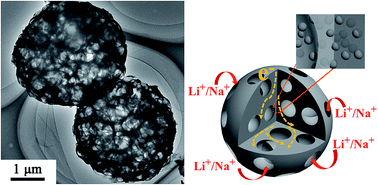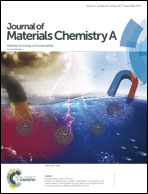Ultrasmall Sn nanodots embedded inside N-doped carbon microcages as high-performance lithium and sodium ion battery anodes†
Abstract
Sn based materials are promising anodes both in Li-ion batteries and Na-ion batteries due to their high theoretical capacities (994 mA h g−1 for LIBs and 847 mA h g−1 for SIBs, respectively). In order to improve the cycle performance, Sn/N-doped carbon microcage composites (Sn/NMCs) with Sn nanodots uniformly embedded inside the N-doped carbon microcages are synthesized through a simple spray drying process, followed by thermal treatment. When used as electrodes, Sn/NMCs exhibit an initial reversible capacity of 780 mA h g−1 at 200 mA g−1, and maintain 472 mA h g−1 after 500 cycles in LIBs. For Na-ion batteries, Sn/NMCs deliver an initial reversible capacity of 439 mA h g−1 at 50 mA g−1 and maintain 332 mA h g−1 after 300 cycles. The remarkable electrochemical performance is mainly owing to the advanced structure of Sn/NMCs, which could be attributed to the pore-formation using NaCl, and the grain size inhibition of Sn using N-doped carbon. Moreover, this preparation method is accessible to scale up and can be extended to fabricate other electrode materials.

- This article is part of the themed collection: 2017 Journal of Materials Chemistry A HOT Papers


 Please wait while we load your content...
Please wait while we load your content...